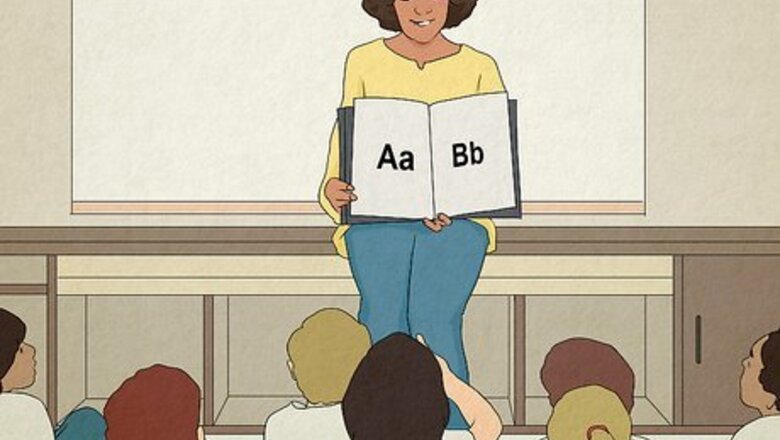
views
- Start by teaching your students the fundamentals, like numbers and the alphabet. Build on those skills with phonics, parts of speech, and basic grammatical skills.
- Create a productive learning environment by speaking to your students in simple language, like “Repeat after me” or “Finish this sentence.”
- Check in with your students often to make sure they understand the content, but avoid using vague questions like “Do you understand?”
Essential Lesson Components
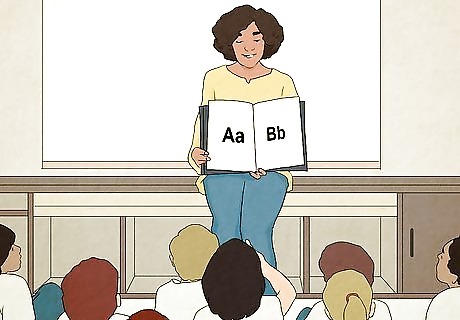
Alphabet and numbersStarting with lessons about the alphabet and teaching number-related lessons provides your students with a great foundation for future learning. It helps to give your students a short test (like filling in the blanks of a partially-completed alphabet) to see what their base skill level is. The Beginning Alphabetics Tests & Tools (BATT) pamphlet is a very helpful resource for teaching your ESL students about the alphabet. Teach your students learn the alphabet up to a certain point if you’d rather teach the lesson in chunks—start at "A" and go to "M," for example. Have your students finish the alphabet at a pace you are both comfortable with. The point is to push your students without pushing them too hard. Try using flashcards with a word that begins with each letter of the alphabet to reinforce your lesson. Keep in mind that learning the alphabet might be easier to speakers whose native language uses the Latin or English alphabet. When it comes to numbers, start by teaching your students to count up (using your fingers helps). From there, work toward counting down, as well as counting in larger chunks (like counting in 10s and 5s).
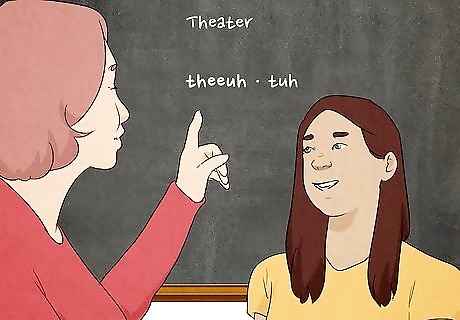
PhonicsTeaching pronunciation is an extremely important part of your ESL lessons. Focus on sounds that are particularly hard for English as a second language students to grasp, like: TH: The "TH" (like in "theater" or "thing") does not exist in certain languages. As a result, it's relatively hard for some ESL students to pronounce. R: The "R" sound is also difficult for many ESL learners, as it’s often pronounced differently across different languages. For instance, French individuals make the “R” sound using their throat. Meanwhile, native Spanish speakers “roll” their “R” sounds. L: The "L" sound is another difficult one for ESL learners, as some languages don’t have the “L” sound in their alphabet. H: The "H" sound is tricky for some ESL learners, since it’s tough to tell when it needs to be pronounced sometimes.
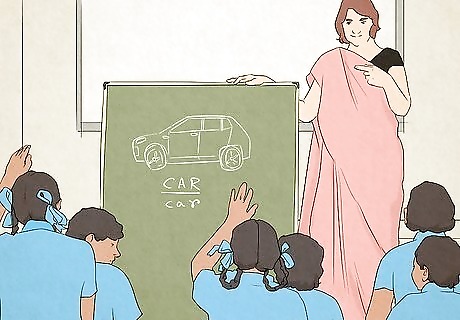
NounsTeaching nouns will be one of the easiest things for your students to learn. Start with common objects in your classroom, before moving on to common objects—good examples are words like car, house, tree, road, and more. Continue on to objects your students will encounter in their daily lives, like food, electronics, and more. Take some time to describe the difference between singular and plural nouns, as well as explain how proper nouns need to be capitalized. Pictures are a great way to help your students understand nouns, as well as fill-in-the-blank exercises. Take some time to talk about English pronouns as well. These include: I, you, he, she, we, they, and them.
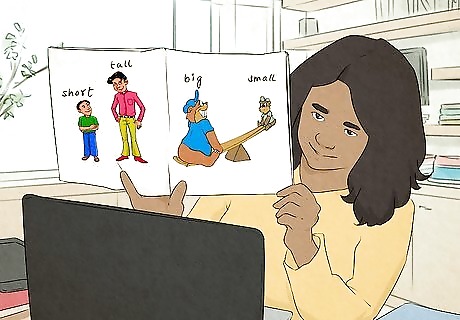
AdjectivesIt helps to teach adjectives right after you teach nouns because adjectives are used exclusively with nouns. Explain how adjectives change or describe other nouns, and provide some examples. For a fun lesson, show your students an interesting picture and invite them to describe it with adjective-filled sentences.
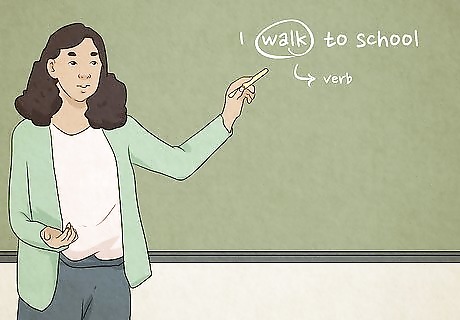
VerbsTeaching verbs will be a huge step in your student’s sentence construction skills. Explain how verbs describe an action, and provide some examples, like jump, run, or become. Spend extra time teaching irregular verbs. The word go is a great example of this, as the past tense of go is went, while the past participle of go becomes gone. Flashcards and role-playing games are just a couple of effective ways to teach verbs in the classroom.
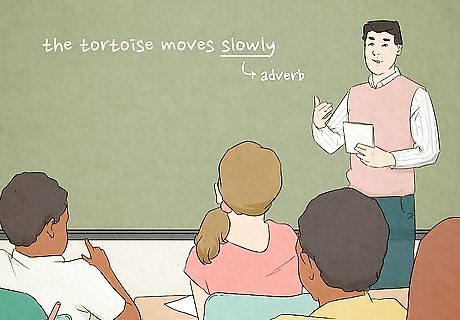
AdverbsExplain how adverbs allow you to add extra details to your sentence, and how your students can use adverbs to clarify how or to what degree they did something. Adverbs also add more detail when using adjectives to describe a noun. If a word ends in -ly, it's likely an adverb.
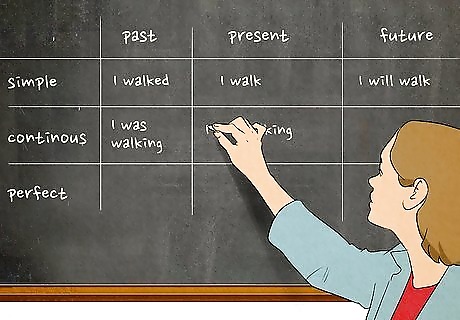
Tenses and articles After you’ve covered nouns, adjectives, verbs, and adverbs you need to move on to teaching tenses and articles to your students. Without understanding how to use the proper tense and where to use articles, your students will not be able to put whole sentences together. Tenses explain when something has happened or occurred. Make sure to explain past tense, current tense, and future tense. Articles are adjectives that provide extra information about a noun. Articles include: a, an, and the. Make sure your students master tenses and articles, as they are an essential part of sentence writing.

Common phrases One great way to teach English is to encourage your students to practice and use common phrases. This is important, since your students won’t understand the meaning of many common phrases just based off of the literal meaning of the words. Begin with a few common phrases like never mind, no doubt, or make believe. It might also help to provide your students with a list of common phrases to work with and think about. Tell your students to repeat those phrases (and use them) until they feel comfortable using them in conversation.
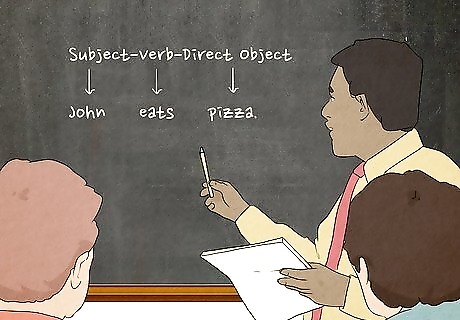
Basic sentence constructionAfter you've taught the alphabet, verbs, and more, you should begin to teach your students basic sentence construction. This is important, as it will provide a foundation to their writing ability, as well as aid them in reading. Focus on the main patterns that sentences in English are constructed around: Subject-Verb: These sentences have the subject followed by a verb. For instance, "The dog runs." Subject-Verb-Direct Object: These sentences have the subject first, followed by a verb, which is then followed by an object. For instance, "John eats pizza." Subject-Verb-Complement: These sentences have the subject first, a verb, and then an complement (like an adjective, noun, or pronoun). For instance, "The puppy seems healthy." Subject-Verb-Indirect Object-Direct Object: These sentences have the subject, a verb, an indirect object, and then a direct object. For instance, "She gave my mom a casserole." Subject-Verb-Direct Object-Object Complement: These sentences have a subject, a verb, a direct object, and end with an object complement (like an adjective, noun or pronoun). For instance, "My sister made the cat frustrated."
Best Classroom Practices

Speak to your students with simple language. Think about the simplest and easiest way to communicate with your students, whether that’s teaching a lesson or providing instructions. Your pupils will have an easier time grasping what you’re trying to say if you use basic sentences. For instance, “Turn to page 63” is much easier to understand than “Please open your textbooks and flip to page 63 in Chapter 4.”

Encourage students to speak more English in the classroom. One great way to facilitate learning is to encourage students use English instead of their first language. This helps use their knowledge of English and further develop them. It also provides teaching moments for instructors and learning opportunities for students. This tactic is best used when students have already learned the basics (basic questions, greetings, the alphabet, and numbers). This tactic works well with the “repeat after me” and/or “answer me” approach. For instance, make a statement or ask a student a question to give them the opportunity to answer in English.

Provide verbal and written instructions. When explaining an activity or giving directions about homework, classwork, or a project, give both verbal and written instructions. Providing both verbal and written instructions allows your students to hear words and see them in print at the same time, which aids in word association and pronunciation. Print off directions to an activity and distribute them to students before you explain an activity. If you are teaching online, email directions to your students before you explain it to them via video.
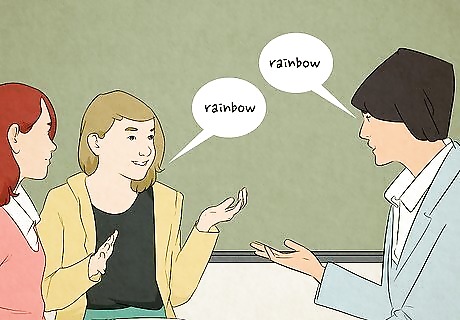
Do drill exercises to help your students learn. Ask your students to listen as you say a certain word, and then ask them to repeat it back to you. Continue using this exercise in the classroom to help your students understand new topics and concepts. Feel free to use drills in all sorts of different ways, like asking students a question and expecting them to answer with a specific response.

Check in with your students to make sure they understand everything. Take time in class to see how your students are faring with the lesson, like asking them to give a thumbs up or thumbs down sign. Steer clear of questions like “Do you understand?” or “Does anyone have questions?” These don’t give you good insight into how your students are really feeling. If you’re teaching in a classroom environment, walk around and talk to students to see if they are having trouble. If you’re teaching online, send messages or emails to students and ask them if they need help. Make yourself available as much as possible when students are doing in-class activities or other activities.

Utilize a variety of teaching styles in the classroom. Teaching English as a second language to beginners is a lot more effective when you use various types of teaching. Diversity in learning is important since each student is different and learns differently. Here are a few ideas you might try: Speaking with a variety of intonations Using gestures as you teach Supplementing lessons with visuals and sketches
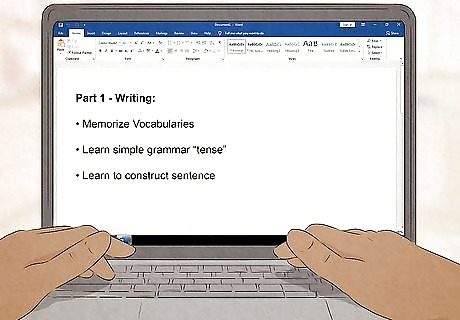
Break lessons into small pieces. When teaching beginners or very young students, break the lesson into several pieces of about 10 minutes—this helps ensure that you don’t lose your students' attention or overwhelm them. You don’t need to stay at exactly 10 minutes. Feel free to go a few minutes over if it will aid your lesson. After each mini-lesson, switch to a totally different sort of lesson. This will help refresh students and keep their attention. Change your mini lessons daily. Try to incorporate as many different lessons as possible to keep your students' attention and to challenge them. However, don't add too much new information at once, so your students don’t get overwhelmed. Instead, change your strategy often but stick to the same material until your students understand it.

Remind your students that it’s okay to make mistakes. Learning a new language isn’t easy—but a few words of encouragement from you go a long way. Explain the struggles you had as you learned English growing up, and feel free to share some mistakes that you made in the past.
Fun Teaching Strategies

Reinforce the topic of the day with games. Games help students learn English by providing a fun and compelling way to think in new and different ways. Try a Jeopardy-type game that uses a point system to get your students to compete against each other. Create different categories, along with questions of varying difficulties that match up with different money values ($100 questions are easy, while $600 questions are harder). Consider a Family Feud-style game if you want your students to work together in teams. During the game, write a category on the chalkboard or whiteboard (like “Popular Foods”) and have each team come up with 8-10 answers. Then, provide the correct answers and have the opposing teams grade each others’ answer sheets. Try a Taboo-style game where your students break into teams and try to describe a word written on the chalkboard/whiteboard without using the word itself. The student guessing sits with their back to the board, and has to rely entirely on their team for hints.
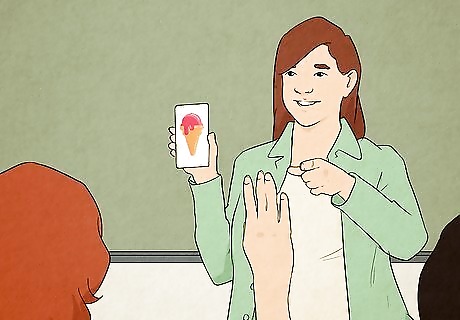
Use visuals to teach language. An important way to teach language is to use visuals in order to build word association. By using visuals to promote word association, your students can make stronger connections between ideas and new words that they are learning in your class. Consider: Pictures and photographs. Post-cards. Video. Maps. Restaurant menus.

Invite your students to use language-learning apps. Targeted language apps are a great way to reinforce what you have taught during instruction time, as students use them to practice their language skills and to learn new phrases and words. Apps like Duolingo, Babbel, and Drops are all great options to consider. Targeted language apps are available on a number of smartphone operating systems. Some apps provide the opportunity for multiple students to work together to learn.
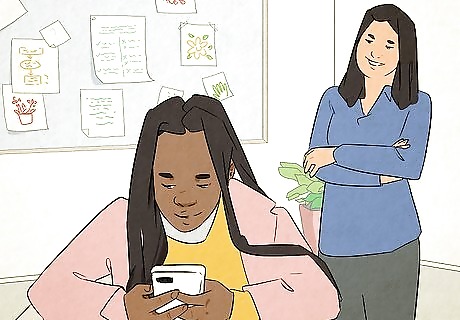
Encourage students to practice their language skills on social media. Invite your students to follow English-speaking accounts, as well as engage with these accounts by replying to posts in English. You could also encourage students to make a separate social media account where they can practice posting in English. Try an “idiom of the day” lesson. In this, pick common idioms or colloquial phrases, and explain them to your class. Have your students follow popular figures on Twitter and translate their tweets. Start a social media group and have students share news pieces and explain or translate them in English.















Comments
0 comment